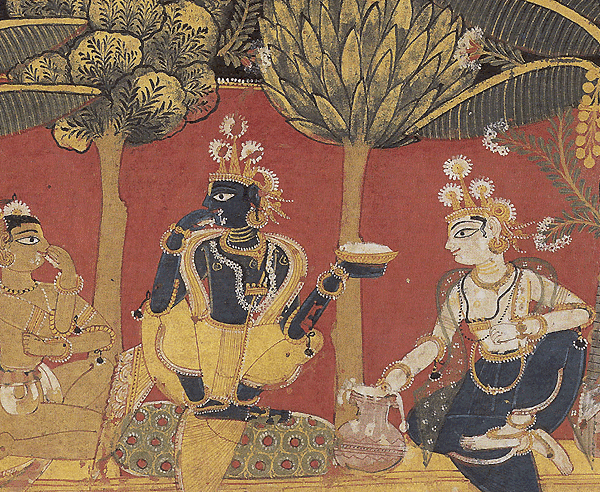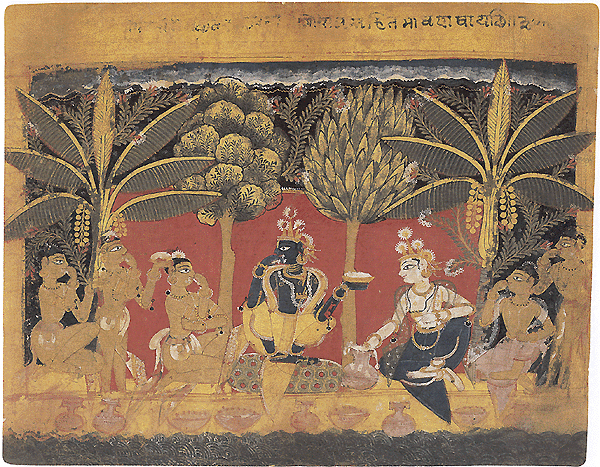
|
|
|
|
Intimate Worlds - Monsoon Pastimes Nov 24, CANADA (SUN) — Krsna Consciousness in Art Criticism. Included in the book Intimate Worlds, which documents the Alvin O. Bellak collection of Indian paintings, is the beautiful painting show here, entitled "Krishna Shares Food with Balarama and the Cowherds During the Rainy Season". This painting is a page from a dispersed series of the Bhagavata Purana, Northern India, probably Rajasthan, c. 1570-75, Opaque watercolor on paper. The authors of Intimate Worlds describe an erroneous comment on the verso of the painting, which incorrectly identifies the scene depicted here: "The pastoral scene of Krishna and his brother Balarama enjoying a midday repast with cowherds belongs to a series known as the Isarda Bhagavata Purana, so called because it was discovered in modern times in Isarda in eastern Rajasthan. [ ] A short inscription on the reverse provides the caption "Krishna is eating butter." This phrase has led to the painting's identification as a representation of the pleasurable results of Krishna's childhood prank of stealing butter from his foster mother's pots, an endearing scene from the eighth chapter of the Bhagavata Purana illustrated frequently in painted copies of the text. This identification is belied by several features of this painting. First, Krishna and Balarama wear crowns, an attribute absent in all representations of their childhood exploits. Krishna's companions here are also exclusively cowherds, and do not include the monkeys who normally partake of his pilfered delights. In fact, the painting depicts the renewal of the earth and its inhabitants during the rainy season, and illustrates the verse wherein Krishna and Balarama are beholding the bounty of the rains as they sit near the water and share rice and curds with the cowherds." The scene of this painting is somewhat formal, given the row of serving pots in the foreground. The ochre ground and borders of the painting frame it, creating a space like the interior of a house, although the lush trees clearly indicate the scene is outdoors. The cowherd boy on the left is somewhat elevated, almost as though sitting on a platform, while Krsna sits on a brightly decorated pillow. This scene is entirely different from not only the typically interior views of Krsna's butter stealing pastimes, but also of the many Vrindavan scenes of Krsna enjoying food with the cowherds. In this case, rather than relaxing out in the meadow with the cows while having their lunch, the scene indicates a more organized feast. The friends enjoy a number of different preparations, as evidenced by the various pots and bowls. Krsna's elevated asana and the rich crowns and clothing worn by he and Balarama create an obvious difference between the brothers and their cowherd friends. This certainly helps to establish the structured nature of the pastime for the viewer. In truth, the cowherd boys had no idea that there was such a vast difference between themselves and their beloved friends, Krsna and Balarama. In his lecture on Nectar of Devotion from Bombay, January 1, 1973, Srila Prabhupada explained: "Just like the cowherd boys, the gopis, they are on the same platform of Krsna. They do not think that "We are lesser than Krsna." The cowherds boy, they sometimes chastise Krsna. Krsna is obliged to take them on the shoulder. Sometimes. They do not know that Krsna is God, or "Krsna is greater than me." That is the position. Equality. Therefore Sukadeva Gosvami said: dasyam gatanam para-daivatena mayasritanam nara-darakena sakam vijahruh krta-punya-punjah
Aside from the opulence of Krsna and Balarama's costume and paraphernalia, there are several indications that the cowherds are enjoying a special pastime together. The number of food dishes set in a row certainly gives the appearance of a feast. Interestingly, Krsna and all of the cowherds are busy eating, with the exception of Balarama, who is serving. Balarama is spooning the curd into a dish held by Krsna, who then distributes the nectar to each of the cowherds. Only one of the cowherds has his own bowl, and the rest are simply eating from hand to mouth, creating a sweet sense of their complete dependence on the Supreme Personality. While the figures are posed quite formally, it's also interesting to note how the artist depicted the curd being eaten by the participants. Particularly on the left, the cowherds have curd on their chins and fingers, adding a delightful element to the painting. The reserved mood of this painting is in contrast to other depictions of the cowherd boys sharing curd, such as the scene described in Srimad Bhagavatam 10:5:14: "In gladness, the cowherd men enjoyed the great festival by splashing one another's bodies with a mixture of curd, condensed milk, butter and water. They threw butter on one another and smeared it on one another's bodies. Purport: From this statement we can understand that five thousand years ago not only was there enough milk, butter and curd to eat, drink and cook with, but when there was a festival it would be thrown about without restriction. There was no limit to how extensively milk, butter, curd and other such products were used in human society. Everyone had an ample stock of milk, and by using it in many varied milk preparations, people would keep good health in natural ways and thus enjoy life in Krsna consciousness." So while the boys aren't being overly exuberant with their curd in this scene, the many pots and bowls certainly indicate the opulence of foodstuffs made available by the mercy of the Lord.
 Intimate Worlds goes on to describe the painting's technical aspects: "Trees establish the requisite forest setting, but it is their variety of form and richness of description that evoke the burgeoning environment. Similarly, the band of water at the bottom satisfies the textual prescription, but it is really its undulating contour, simultaneously echoing the rumbling rain clouds and stirring as assortment of earthen vessels to bob animatedly, which conjures up the life giving power of water." As is typical in paintings of this style, the fruits hang from the trees like garlands. That, and the sword-like palm fronds reaching vertically above on either side create an altar-like tableaux. "The attention to clarity of shape and design [of the trees] is carried through to other elements. Flaring garments terminate in well-defined shapes, gauzy scarves become convincingly translucent, and jewelry and garlands congeal to the point that individual stones and petals are clear. [ ] The figures themselves have very distinctive faces, with a sweeping jaw, an elongated eye…" "…The red rectangle - a standard element in paintings of this style - is used to particularly brilliant effect. It rivets attention on the central core of the painting, primarily by virtue of the vibrant color contrasts it initiates with the blue Krishna, the white-skinned Balarama, the greenish cowherds, and the black sky, but also by establishing an oasis of plain ground amid the surrounding vegetal exuberance."
| |
